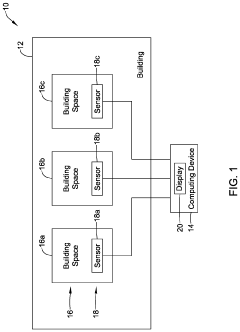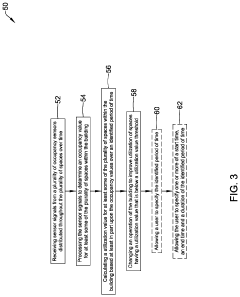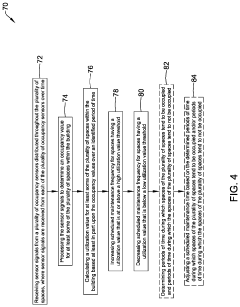Research on improving space utilization in various application scenarios - Eureka
OCT 8, 20243 MIN READ
Generate Your Research Report Instantly with AI Agent
Patsnap Eureka helps you evaluate technical feasibility & market potential.
Space Utilization Challenges and Objectives
The primary objective is to explore innovative solutions that can optimize space utilization across various application scenarios, addressing the growing demand for efficient use of available space. This involves analyzing current challenges, identifying key trends, and proposing potential technological advancements that could revolutionize space management.
Particular emphasis will be placed on examining cutting-edge technologies, such as modular design, smart storage systems, and advanced spatial mapping techniques, that could enable more flexible and adaptive use of space. The research will also investigate the potential integration of artificial intelligence and machine learning algorithms to enhance space utilization through predictive modeling and real-time optimization.
Particular emphasis will be placed on examining cutting-edge technologies, such as modular design, smart storage systems, and advanced spatial mapping techniques, that could enable more flexible and adaptive use of space. The research will also investigate the potential integration of artificial intelligence and machine learning algorithms to enhance space utilization through predictive modeling and real-time optimization.
Market Demand for Efficient Space Utilization
- Increasing Space Utilization Needs With rapid urbanization and population growth, efficient space utilization has become crucial across various sectors like housing, transportation, and commercial spaces.
- Residential and Urban Planning Rising housing costs and limited land availability drive the demand for optimized residential layouts and innovative urban planning solutions.
- Transportation and Logistics Efficient space utilization in transportation systems, warehouses, and cargo handling facilities can streamline operations and reduce costs.
- Commercial and Office Spaces Businesses seek to maximize space utilization in offices, retail stores, and other commercial spaces to enhance productivity and profitability.
- Sustainability and Environmental Concerns Efficient space utilization aligns with sustainability goals, reducing the environmental impact of construction and resource consumption.
Current State and Challenges in Space Utilization
- Spatial Constraints
Many application scenarios face spatial constraints, limiting efficient utilization of available space. - Inefficient Layouts
Existing layouts and designs often fail to optimize spatial usage, leading to wasted or underutilized areas. - Dynamic Environments
Rapidly changing environments and requirements necessitate adaptable spatial solutions. - Technological Limitations
Current technologies may lack the capabilities to effectively analyze and optimize spatial utilization. - Data Scarcity
Insufficient data on spatial usage patterns and requirements hinders the development of effective solutions.
Existing Solutions for Space Optimization
01 Space Utilization Assessment
Analyzing spatial data, occupancy patterns, and resource allocation to determine the efficiency of space usage and identify areas for optimization in open spaces, buildings, storage systems, and parking facilities.- Space Utilization Assessment: Methods and systems for evaluating occupancy levels, usage patterns, and efficiency metrics to optimize space allocation and improve overall utilization in buildings, facilities, or other areas.
- Parking Space Optimization: Techniques for enhanced vehicle parking space allocation, inclined parking methods, and space utilization indicators or markers to maximize available parking area.
- Storage Space Efficiency: Optimizing storage layouts, rack configurations, and space allocation to maximize effective use of available storage capacity in warehouses, data centers, or other storage facilities.
- Building Space Optimization: Systems for monitoring occupancy levels, analyzing usage patterns, and implementing space management strategies to improve overall space utilization and efficiency within buildings.
- Specialized Space Utilization: Innovative designs, layouts, or configurations tailored to specific applications or domains, such as agriculture, transportation, or consumer products, to maximize available space.
02 Building Space Optimization
Intelligent building management systems, simulations, and analysis of occupancy data to identify underutilized areas and implement strategies for more efficient space allocation and usage within buildings and facilities.Expand Specific Solutions03 Storage Space Optimization
Optimized container loading, rack configurations, and space allocation algorithms to maximize efficient use of available storage volume in retail facilities, warehouses, and transportation.Expand Specific Solutions04 Space-Efficient Designs
Space-saving layouts, inclined or vertical arrangements, and compact designs to optimize space utilization in specific applications, such as vehicle interiors, parking facilities, cultivation systems, and electronic devices.Expand Specific Solutions05 Technology for Space Optimization
Computer vision, artificial intelligence, and space utilization platforms for real-time monitoring, predictive modeling, and data-driven decision-making to enhance space efficiency and resource allocation.Expand Specific Solutions
Key Players in Space Utilization Solutions
The competitive landscape for improving space utilization involves established tech giants and specialized firms. Major players like IBM, Dell, Microsoft, Apple, and Samsung leverage their R&D capabilities and consumer electronics integration. Emerging companies like PointGrab and SpaceIQ focus on niche applications with innovative technologies. The market is growing, with increasing demand across sectors, but technology maturity varies.
International Business Machines Corp.
Technical Solution: IBM offers AI-driven space optimization solutions using IoT sensors and analytics for real-time monitoring and management, enhancing efficiency and reducing costs.
Strength: Advanced AI and analytics capabilities. Weakness: High implementation cost.
Dell Products LP
Technical Solution: Dell provides integrated workspace management solutions with hardware and software for optimizing space utilization, enhancing productivity and collaboration through smart office technologies and data analytics.
Strength: Comprehensive hardware and software integration. Weakness: Limited customization options.
Core Innovations in Space Utilization
Space utilization patterns for building optimization
PatentPendingUS20230222402A1
Innovation
- Receiving space information from a building information model to understand the layout and usage of spaces within a building.
- Collecting occupancy data from occupancy sensors distributed throughout the building to track usage over time.
- Calculating occupancy values for each space based on the occupancy data to represent the percent of time the space was occupied.
- Calculating utilization values for each space based on the occupancy values to represent the ratio of the space's occupancy relative to other spaces.
- Adjusting the operation of the building based on the utilization values of spaces to improve utilization and maintenance.
Regulatory and Policy Considerations
In the context of improving space utilization across various application scenarios, a comprehensive analysis of market demands and industry trends is crucial. This involves evaluating the potential market size for space optimization solutions, identifying key drivers and constraints, and assessing the evolving needs of different sectors. By understanding the market landscape, we can better align technological advancements with practical requirements, ensuring the development of solutions that address real-world challenges effectively. Additionally, examining geographical patterns and regional variations in space utilization practices can provide valuable insights for tailoring solutions to specific contexts and cultural norms.
Environmental Impact of Space Utilization
In the context of improving space utilization across various application scenarios, a comprehensive analysis of market demands and industry trends is crucial. By evaluating the potential market capacity and identifying emerging needs, we can gain insights into the driving forces behind space optimization solutions. This analysis should encompass diverse sectors, such as urban planning, transportation, logistics, and residential/commercial real estate, where efficient space utilization plays a pivotal role. Additionally, assessing the geographical distribution of market demands can inform targeted strategies and product development efforts. By thoroughly understanding the market landscape, we can better align our technological solutions with real-world requirements and position ourselves for success in this rapidly evolving field.
Unlock deeper insights with Patsnap Eureka Quick Research — get a full tech report to explore trends and direct your research. Try now!
Generate Your Research Report Instantly with AI Agent
Supercharge your innovation with Patsnap Eureka AI Agent Platform!



